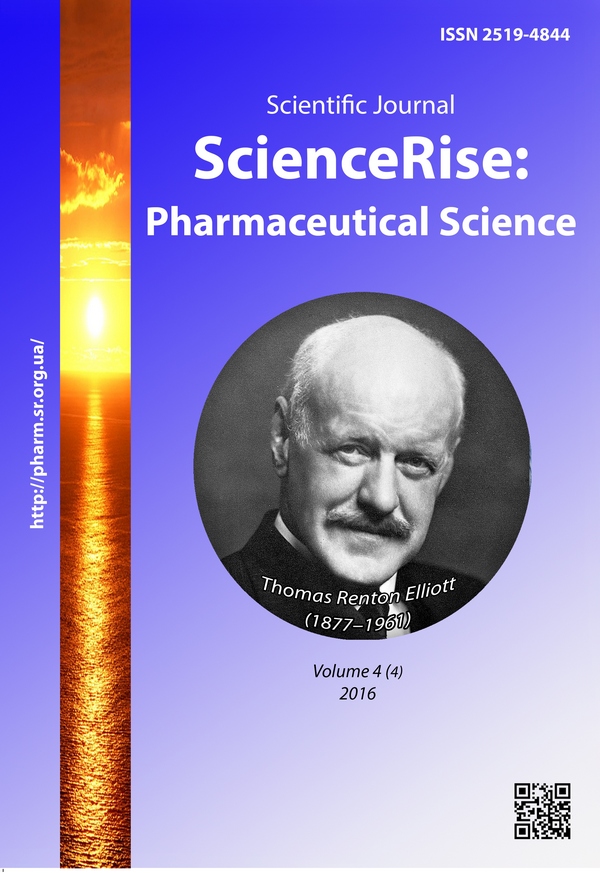Хронічна токсичність субстанції адамантан-1-амонієвої солі 2-(5-(адамантан-1-іл)-4-феніл-1,2,4-тріазол-3-ілтіо)оцтової кислоти
DOI:
https://doi.org/10.15587/2519-4852.2016.87466Ключові слова:
Випробування на хронічну токсичність, доклінічні дослідження, 1, 2, 4-триазол, адамантан, експерименти на тваринах, лікиАнотація
На сьогодні лише сім похідних адамантану пройшли клінічні випробування як лікарські засоби для лікування вульгарних вугрів, хвороби Альцгеймера, діабету 2-го типу, як противірусні. Інші знаходяться в стадії розробки як потенційні терапевтичні засоби для лікування захворювань, пов’язаних з перевантаженням залізом, малярії, туберкульозу, неврологічних та онкологічних захворювань, як антиоксидантні та протизапальні.
Метою нашого дослідження було вивчення хронічної токсичності адамантан-1-амонієвої солі 2-(5-(адамантан-1-іл)-4-феніл-1,2,4-тріазол-3-ілтіо)оцтової кислоти для отримання інформації про синдроми токсичності та подальшого дослідження як потенційного лікарського засобу.
Методи. Вивчення хронічної токсичності субстанції адамантан-1-амонієвої солі 2-(5-(адамантан-1-іл)-4-феніл-1,2,4-тріазол-3-ілтіо)оцтової кислоти проводились відповідно до вимог з доклінічного вивчення нових лікарських засобів. При виборі доз досліджуваної субстанції керувалися даними доклінічних досліджень специфічної активності та результатів визначення ОД50 і ЛД50.
Експериментальні тварини знаходились в окремому приміщенні і розподілялися в групи по 7 особин. Тварини перебували на стандартному раціоні харчування, отримуючи добавку протягом усього експерименту. Субстанцію готували для введення у вигляді водної суспензії. Контрольна група з 7 тварин отримувала очищену воду в однаковому об’ємі. Перед введенням субстанції тварини знаходились без прийому їжі протягом 16 годин, отримували препарат і плацебо вранці в один і той же час.
Результати.У процесі хронічного експерименту не було летальних випадків щурівта проявів очевидної токсичності. Не встановлено відхилень параметрів зовнішнього вигляду, поведінкових реакцій, споживання корму та води, які були б пов’язані з застосуванням 2-(5-(адамантан-1-іл)-4-феніл-1,2,4-тріазол-3-ілтіо)оцтової кислоти. Не виявлено також істотних змін або негативних ефектів, пов’язаних із введенням субстанції.
Висновки. Доклінічне вивчення токсичних властивостей адамантан-1-амонієвої солі 2-(5-(адамантан-1-іл)-4-феніл-1,2,4-тріазол-3-ілтіо)оцтової кислоти показало, що тварини добре переносять досліджувану субстанцію, не виявляють ознак загальнотоксичної дії та не було летальних випадків.
За характером токсичної безпечності дана субстанція є перспективноюдля подальшого дослідження як потенційний лікарський засіб
Посилання
- Blanpied, T. A. (2005). Amantadine Inhibits NMDA Receptors by Accelerating Channel Closure during Channel Block. Journal of Neuroscience, 25 (13), 3312–3322. doi: 10.1523/jneurosci.4262-04.2005
- Maugh, T. (1979). Panel urges wide use of antiviral drug. Science, 206 (4422), 1058–1060. doi: 10.1126/science.386515
- Sonnberg, L. (2003). The Complete Pill Guide: Everything You Need to Know about Generic and Brand-Name Prescription Drugs. Barnes & Noble Publishing, 87.
- Ebtehal Suliman Al Abdullah. (2007). Synthesis and biological testing of new 1-adamantyl derivatives. Riyadh, Saudi Arabia, 147.
- Skolimowski, J. (2003). Synthesis and antioxidant activity evaluation of novel antiparkinsonian agents, aminoadamantane derivatives of nitroxyl free radical. Bioorganic & Medicinal Chemistry, 11 (16), 3529–3539. doi: 10.1016/s0968-0896(03)00299-2
- Zakon Ukrai'ny «Pro likars'ki zasoby» (1996). Verhovna Rada Ukrai'ny, # 123/96-VR. Available at: http://zakon2.rada.gov.ua/laws/show/123/96-vr
- Nakaz Ministerstva ohorony zdorov’ja Ukrai'ny «Pro zatverdzhennja Porjadku provedennja doklinichnogo vyvchennja likars'kyh zasobiv ta ekspertyzy materialiv doklinichnogo vyvchennja likars'kyh zasobiv» (2009). MOZ Ukrai'ny, # 944. Available at: http://zakon3.rada.gov.ua/laws/show/z0053-10
- Pinto, L. H., Holsinger, L. J., Lamb, R. A. (1992). Influenza virus M2 protein has ion channel activity. Cell, 69 (3), 517–528. doi: 10.1016/0092-8674(92)90452-i
- Al-Deeb, O., Al-Omar, M., El-Brollosy, N., Habib, E., Ibrahim, T., El-Emam, A. (2011). Synthesis, Antimicrobial, and Anti-inflammatory Activities of Novel 2-[3-(1-Adamantyl)-4-substituted-5-thioxo-1,2,4-triazolin-1-yl]acetic Acids, 2-[3-(1-Adamantyl)-4-substituted-5-thioxo-1,2,4-triazolin-1-yl]propionic Acids and Related Derivatives. Arzneimittelforschung, 56 (01), 40–47. doi: 10.1055/s-0031-1296699
- Kadi, A. A., El-Brollosy, N. R., Al-Deeb, O. A., Habib, E. E., Ibrahim, T. M., El-Emam, A. A. (2007). Synthesis, antimicrobial, and anti-inflammatory activities of novel 2-(1-adamantyl)-5-substituted-1,3,4-oxadiazoles and 2-(1-adamantylamino)-5-substituted-1,3,4-thiadiazoles. European Journal of Medicinal Chemistry, 42 (2), 235–242. doi: 10.1016/j.ejmech.2006.10.003
- Giacino, J. T., Whyte, J., Bagiella, E., Kalmar, K., Childs, N., Khademi, A. et. al. (2012). Placebo-Controlled Trial of Amantadine for Severe Traumatic Brain Injury. New England Journal of Medicine, 366 (9), 819–826. doi: 10.1056/nejmoa1102609
- Kumar, C., Kwong, H., Mah, S., Chia, T., Loh, W.-S., Quah, C. et. al. (2015). Synthesis and Crystallographic Insight into the Structural Aspects of Some Novel Adamantane-Based Ester Derivatives. Molecules, 20 (10), 18827–18846. doi: 10.3390/molecules201018827
- Lepahin, V. K., Astahova, A. V., Ushkalova, E. A., Illarionova, T. S., Fitilev, S. B., Shkrebneva, I. I. (2008). Razrabotka metodov izuchenija i profilaktiki oslozhnenij farmakoterapii. Moscow: RUDN, 225.
- Stefanov, O. V. (Ed.) (2001). Doklinichni doslidzhennja likars'kyh zasobiv. Kyiv: Vyd. dim "Avicena", 527.
##submission.downloads##
Опубліковано
Як цитувати
Номер
Розділ
Ліцензія
Авторське право (c) 2016 Віра Миколаївна Одинцова, Андрій Володимирович Абрамов, Ігор Федорович Бєленічев

Ця робота ліцензується відповідно до Creative Commons Attribution 4.0 International License.
Наше видання використовує положення про авторські права Creative Commons CC BY для журналів відкритого доступу.









